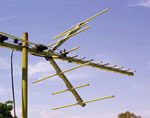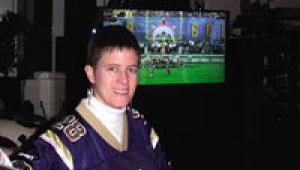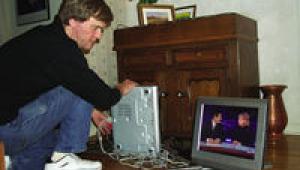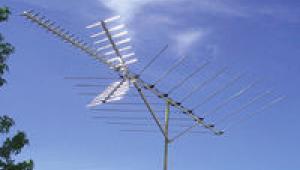Home Theater Boot Camp: Receiving HDTV
You used to be able to buy a TV, plug it into an antenna or cable outlet, and start flipping channels. It was an amazingly simple system. Digital television and its high-resolution subsystem, high-definition television, aren't quite as plug-and-play . . . yet. Antennas only pick up high-def signals in some markets; cable usually doesn't pick them up at all. Satellite seems like a good bet, but it doesn't offer everything. Plus, certain DTV tuners don't work with certain displays. It's enough to drive any self-respecting videophile to drink (not that we'd fault you for that). But there is hope. The following three-step guide is intended to make setting up an HDTV system easier than following that other multistep program. First, figure out what sources are available to you, then find a tuner that works with those sources. Finally, buy a high-definition display that works with that tuner.
 |
| A. A larger UHF/VHF antenna receives channels 2 through 83 and is good for general TV reception. |
Step 1: Determining Your Source Options
You'll need to do some homework before you embark on your quest for DTV. Fortunately for you, we've provided most of the info right here in this article. HDTV is available from three different places. The first and most abundant source is terrestrial (over-the-air) broadcasts that you receive through an aerial (rooftop) antenna. Depending on where you live, you might even be able to use rabbit ears or a bow-tie-type antenna, or you could install a larger antenna in your attic. In most places, a $30-to-$40 UHF/VHF rooftop antenna from RadioShack will do the trick. This is currently the best way to receive primetime network broadcasts from ABC, NBC, CBS, and Fox. For a listing of the programs these networks broadcast in DTV/HDTV, go to http://www.hometheatermag.com/hdtv.shtml.
Figure 1 (link at sidebar) provides a listing from the Federal Communications Commission (www.fcc.gov/mmb/vsd/files/dtvonair.html) and the National Association of Broadcasters (www.nab.org/newsroom/issues/digitaltv/dtvstations.asp) of stations that are broadcasting digital television signals. See if your local stations are on the list. Also, note which channels these stations are using for their DTV broadcasts. If all the channels are in the UHF range (channels 14 through 83), you'll only need a UHF antenna, which is much smaller than a VHF antenna. Otherwise, you'll probably need to get an antenna that can pull in both UHF and VHF.
Next, you'll want to determine if you can receive these terrestrial transmissions, and the Consumer Electronics Association has a Website for just this purpose: www.antennaweb.org. Type in your address, and the site will give you a map of your area, like the one in Figure 2. Then, depending on which stations you want to receive, the site will tell you exactly what type of antenna system you'll need. In most cases, all of the local transmitters are in one location. You need to be within at least 60 miles of the transmitter, and your line of sight to it should be unobstructed. In other words, there should be no mountain ranges between you and the transmitter. If the local TV stations' transmitters are in two locations, you may need a special antenna or an antenna rotor. If you can receive analog signals from an antenna, you can probably receive digital signals, as well. For $30 (the cost of the antenna), it's worth testing. I was surprised by how many addresses I tested that came back with positive results.
 |
| B. A smaller UHF antenna (or the front portion of a UHF/VHF antenna) receives channels 14 through 83, where most DTV stations reside. |
The second most common source of HDTV signals is satellite transmissions. DirecTV offers HBO, Showtime, a part-time pay-per-view channel and the Marc Cuban sports channel, HDNET in high-definition. DISH Network offers HBO, Showtime, Discovery Theater channels in high-definition, in addition to a 24-hour pay-per-view channel and an HD demo channel. Roughly 60 percent of the movies on HBO and Showtime are in true HDTV; the rest are upconverted from NTSC. Dish Network also offers the national feed of CBS HD, assuming you can't receive the local channel via an antenna. There are no other networks available in satellite in HD. In other words, you won't see The Tonight Show in high-def via satellite. Almost anyone can receive satellite signals, although you may want to check with your dealer, just in case. DISH Network's satellites, for example, are very low on the southern horizon.
In some regions, certain cable systems carry HDTV broadcasts. Which channels these cable systems carry will vary from region to region. Please understand that a "digital cable system" has nothing to do with DTV transmitted via cable. Digital cable is nothing more than regular cable transmitted digitally, albeit with more channels. It's similar to digital satellite. If your cable operator offers digital cable, it's more likely that they also offer DTV on cable (thanks to the additional capacity), but it's not guaranteed. You should contact your local cable operator to find out if they offer HDTV via their cable system. If they do, you might need a specific HDTV cable receiver from them. Be sure the cable tuner is compatible with your display (see below).


















































